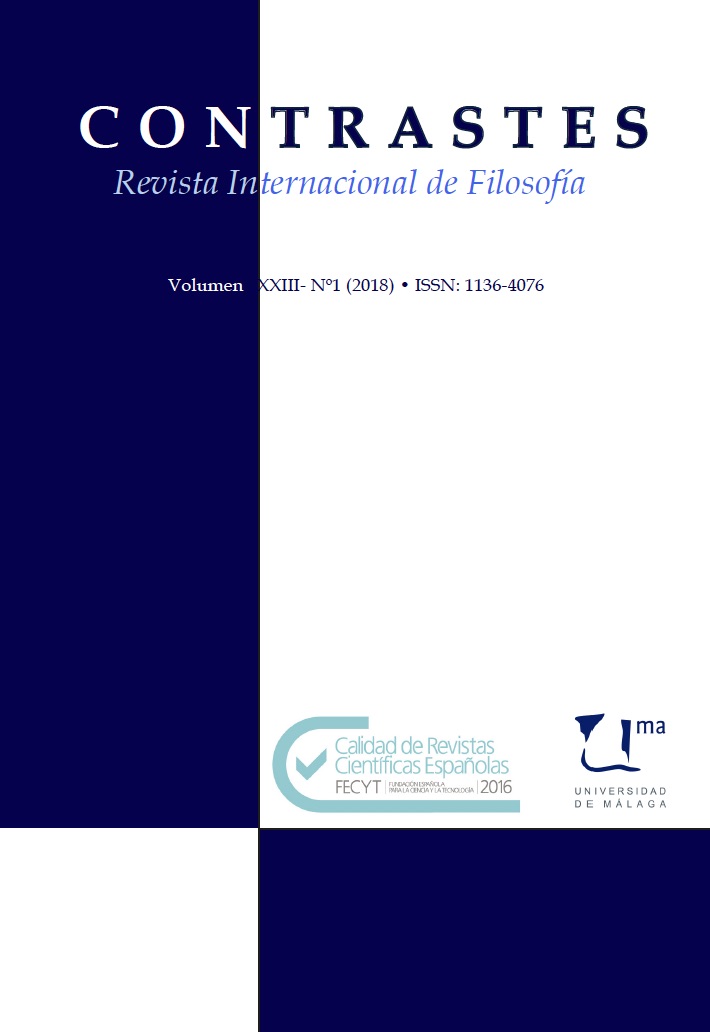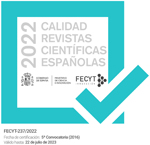Kierkegaard, el autor sin público. Notas sobre la lectura a propósito de To Tidsaldre
DOI:
https://doi.org/10.24310/Contrastescontrastes.v23i1.5461Palabras clave:
Kierkegaard, Autor, Público, Cuerpo, IntimidadResumen
El propósito de este estudio consiste en mostrar la crítica de Kierkegaard a la metafísica de la lectura a través de su problematización de la noción de autor y su revisión de la noción de público en su obraDos épocas. Una recensión literaria. Para ello, se rechazará la interpretación habitual de esta obra, basada en la distinción público/privado, y se valorará la propuesta de Kierkegaard mediante las nociones de cuerpo e intimidad. Ello implicará una redefinición del lenguaje desde el secreto y el silencio, y apuntará hacia una relación compleja entre la literatura, el cuerpo, la subjetividad y la religión.Descargas
Métricas
Citas
ADORNO, Th. W. 2006: Kierkegaard. Construcción de lo estético, trad. de Joaquín Chamorro Mielke. Madrid: Akal.
BENJAMIN, W. 2012: Denkbilder, trad. de Jorge Navarro Pérez. Madrid: Abada Editores.
BENJAMIN, W. 2009: «El narrador. Consideraciones sobre la obra de Nikolái Léskov» en Obras completas, libro II/vol. 2, trad. Jorge Navarro Pérez, pp. 41-68. Madrid: Abada
Editores.
BERTHOLD, D. 2006: «A Question of Style: Hegel and Kierkegaard on Language, Communication, and the Ethics of Authorship», Clio 35 (2), pp. 179-200
BERTHOLD, D.2005: «Kierkegaard’s Seductions: The Ethics of Authorship», MLN 120 (5), pp. 1044-1065.
CAPUTO, J. D. 2007: How to read Kierkegaard?. London: W. W. Norton & Company
CAPUTO, J. D 2002. «Looking the Impossible in the Eye: Kierkegaard, Derrida, and the Repetition of Religion», Kierkegaard Studies Yearbook 2002 (1), pp. 1-25.
CAPUTO, J. D 2001. On religion. London: Routledge.
CAPUTO, J. D 1997: The Prayers and Tears of Jacques Derrida. Religion without Religion. Bloomington: Indiana University Press.
CAPUTO, J. D., DOOLEY, M. y SCANLON, M. J. 2001: Questioning God. Bloomington: Indiana University Press.
CONANT, J. 1997: «Kierkegaard’s Postscript and Wittgenstein’s Tractatus: Teaching How to Pass from Disguised to Patent Nonsense», Wittgenstein Studien 4 (2), pp. 1-35.
CONANT, J. 1996: «Putting Two and Two Together: Kierkegaard, Wittgenstein and the Point of View for Their Work as Authors», en Phillips (ed.), The Grammar of Religious Belief. Nueva York: St. Martin’s Press, pp. 249-331.
CONWAY, D. W. 1999: «Modest Expectations: Kierkegaard’s Reflections on the Present Age», Kierkegaard Studies Yearbook 1999 21-49.
CORTES FAVIS, M. 2009: «The Concept of Writing, with Continual Reference to ‘Kierkegaard’», The European Legacy: Toward New Paradigms, 14 (5), pp. 561- 572, DOI: 10.1080/10848770903128687.
COWARD, H. y FOSHAY, T. (eds.) 1992: Derrida and Negative Theology. Nueva York: State University of New York Press.
DERRIDA, J. 2005: Force de Loi. París: Galilée.
DERRIDA, J. 2000 : Foi et Savoir, suivi de Le Siècle et le Pardon. Paris : Seuil.
DERRIDA, J. 1999: Donner la mort. París: Galilée.
DERRIDA, J. 1993: Passions. París : Galilée.
DERRIDA, J. y FERRARIS, M. 1997: Il gusto del segreto. Roma: Laterza.
FENVES, P. 1993: «Chatter». Language and History in Kierkegaard. Stanford: Stanford University Press.
GARFF, J. 2003: «‘What did I find? Not my I’ On Kierkegaard’s Journals and the Pseudonymous Autobiography», Kierkegaard Yearbook 2003, pp. 110-124.
GARFF, J. 1999: «‘You Await a Tyrant whereas I Await a Martyr’: One Aporia and its Biographical Implications in A Literary Review,» Kierkegaard Studies Yearbook
, pp. 130-148.
GARFF, J. 1996: «Johannes de silentio: Rethorician of Silence», Kierkegaard Studies Yearbook 1996, pp. 186-210.
GONZÁLEZ, D. 1999: «Kierkegaard et la question de la conceptualité», Kierkegaardina 20, pp. 83-95.
HANNAY, A. 1999: «Kierkegaard Levelling and the Review», Kierkegaard Studies Yearbook 1999, pp. 71-95.
HEIDEGGER, M. 2009: Ser y tiempo, trad. de Jorge Eduardo Rivera. Madrid: Trotta.
HOBERMAN, J. M. 1984: «Kierkegaard’s Two Ages and Heidegger’s Critique of Modernity» en Perkins (ed.), International Kierkegaard Commentary: Two Ages.
Macon, GA: Mercer University Press, pp. 223-258.
JAARSMAT, A. S. 2013: «Kierkegaard, Biopolitics and Critique in the Present Age», The European Legacy. Toward New Paradigms18 (7), pp. 850–866, http://dx.doi.
org/10.1080/10848770.2013.839492
KANGAS, D. 1998: «Kierkegaard, the Apophatic Theologian», Enrahonar. An International Journal of Theoretical and Practical Reason 29, pp. 119-123
KIERKEGAARD, S. 2012a: Temor y temblor, trad. Vicente Simón Merchan. Madrid, Alianza.
KIERKEGAARD, S. 2012b: La época presente, trad. de Manfred Svensson. Madrid: Trotta.
KIERKEGAARD, S. 2011: Post Scriptum no científico y definitivo a «Migajas filosóficas», trad. de Javier Teira y Nekane Legarreta. Madrid: Sígueme.
KIERKEGAARD, S. 2010: Søren Kierkegaards Skrifter. Elektronisk version 1.5, ed. Søren Kierkegaard
Forskningscenteret, sks.dk, Copenhague.
KIERKEGAARD, S. 2009a: The Point of View, Kierkegaard’s Writings, XXII, trad. H. y E. Hong.
Princeton: Princeton University Press.
KIERKEGAARD, S. 2009b: Repetition and Philosophical Crumbs, trad. de Edward F. Mooney. Oxford: Oxford University Press.
KIERKEGAARD, S. 2000: De los papeles de alguien que todavía vive. Sobre el concepto de ironía, Tajafuerce. Madrid: Trotta.
KIERKEGAARD, S. 1987: Two Ages: The Age of Revolution and The Present Age. A Literary Review,
ed. y trans. de Howard V. y Edna H. Hong. Nueva Jersey: Princeton University Press.
KIRMMSE, B. H. 1999: «Apocalypse Then: Kierkegaard’s A Literary Review,» Kierkegaard Studies Yearbook 1999, pp. 182-203.
LAPPANO, D. 2014: «A Coiled Spring: Kierkegaard on the Press, the Public, and a Crisis of Communication», Heythrop Journal 55, pp. 783–798.
LIPPITT, J. y PATTISON, G. (eds.) 2013: The Oxford Handbook of Kierkegaard. Oxford: Oxford University Press.
LISSE, M. (ed.) 1996 : Passions de la littérature. Avec Jacques Derrida. París: Galilée.
LISSE, M. 1992: «Donner à lire», en Rabaté, Jean-Michel y Wetzel, Michael (eds.) : L’éthique du don. Jacques Derrida et la pensée du don. Colloque de Royaumont décembre 1990. París : Métailié-Transition, pp. 133-151
LISSE, M. 2001: L’expérience de la lecture, 2 vols. París : Galilée
LLEVADOT, L. 2012: «La intimitat: de la privacitat del jo a l’escriptura de si», Comprendre 14 (1) 5-19.
LISSE, M. 2008: «Kierkegaard y la cuestión del lenguaje». Daimon. Revista de Filosofía 43, pp. 93-101.
MANNING, E. 2004: «The Possibility of a World without Absolute Truth: Caputo and Kierkegaard on Faith and Religious Belief», Diaporia. Undergraduate Journal for Philosophy and Humanities 1(2), pp. 4-11
MARSH, J. L. 1984: «Marx and Kierkegaard on Alienation,» en Perkins (ed.), International Kierkegaard Commentary: Two Ages. Macon, GA: Mercer University Press, pp. 155-174.
MARTINEZ, R. 2003: «Figuring Kierkegaard’s Relgious Individual», Laval théologique et philosophique 59 (3), pp. 521-533
MATAS PONS, À. 2015: «Falseamiento y consumo de la identidad, de Rousseau a Adorno», Isegoría 53, pp. 631-646. doi: 10.3989/isegoria.2015.053.09
MEHL, P. 2005: «In the Twilight of Modernity: Kierkegaard and Contemporary Reflections on Existential Identity», en Thinking through Kierkegaard. Existential Identity in a Pluralistic World. Illinois: University of Illinois Press, pp. 119-162
PARDO, J. L. 1996: La intimidad. Valencia: Pre-textos.
PATTISON, G. 1999a: «The Present Age: the Age of the City», Kierkegaard Studies Yearbook 1999, pp. 1-20.
PATTISON, G. 1999b: Poor Paris! : Kierkegaard’s Critique of the Spectacular City. Berlin. De
Gruyter.
PERARNAU VIDAL, D. y PARCERO OUBIÑA, Ó. 2009: «Spain: The Old and New Kierkegaard. Reception in Spain,» en Stewart (ed.), Kierkegaard’s International Reception, Tome II, Southern, Central and Eastern Europe, a su vez en Kierkegaard Research: Sources, Reception and Resources, vol. 8, pp. 17- 80. Aldershot: Ashgate.
POOLE. R. 2002: «Towards a Theory of Responsible Reading: How to Read andWhy», Kierkegaard Studies Yearbook 2002, pp. 395-442
ROCCA, E. 2009: «La tâche de ne pas écrire. L’écriture comme non-art », Revue des sciences philosophiques et théologiques 93 (3), pp. 571-83.
ROCCA, E. 2000: «Søren Kierkegaard and Silence», en HOUE, P., MARINO, G. D., y
HAKON ROSSEL, S. (ds.): Anthropology and Authority. Essays on Søren Kierkegaard. Amsterdam: Rodopi, pp. 77-83.
ROGAN, J. 1992: «Keeping Silent through Speaking», en PATTISON, G. (ed.), Kierkegaard on Art and Communication. New York: St. Martin’s Press, pp. 88- 99.
ROSSATTI, G. G. 2016: «Kierkegaard as an Antimodern Moralist: Re-Thinking ‘Socio-Political’ Categories in Recent Kierkegaard Scholarship», Kierkegaard Studies Yearbook 2016 (1) 51-74. doi:10.1515/kierke-2016-0106
SÀEZ TAJAFUERCE, B. 2015: «Kierkegaard y la crítica literaria: la prosa de Andersen», en González, Llevadot y Sàez Tajafuerce (eds.), Kierkegaard y las artes. Pensar la creación. Barcelona: Editorial UOC, pp. 171-186.
SÀEZ TAJAFUERCE, B. 1999: «A Literary Review: A Rhetorical Experiment or ‘Watchman, Hallo!’», Kierkegaard Studies Yearbook 1999, pp. 50-70.
STOKES, P. & BUBEN, A. 2011: Kierkegaard and Death. Bloomington: Indiana University Press.
STRAWSER, M. 2006: «Gifts of Silence from Kierkegaard and Derrida», Soundings 89 (1-2), pp. 55-72.
TAYLOR, M. C. 1994: «Denegating God», Critical Inquiry 20/4, pp. 592-610.
TAYLOR, M. C. 1984: Erring. A Postmodern A/Theology. Chicago: University of Chicago Press.
TAYLOR, M. C. 1981: «Sounds of Silence», Kierkegaard’s Fear and Trembling. Critical Appraisals. Alabama: The University of Alabama Press, pp. 152-165.
WATKIN, J. 1993: «The Journals and the Works of 1843 with Particular Reference to Either/Or», Tópicos 5, pp. 19-51.
WESTFALL, J. 2007: The Kierkegaardian author, authorship and performance in Kierkegaard’s literary and dramatic criticism. Berlín y New York: De Gruyter.
Descargas
Publicado
Cómo citar
Número
Sección
Licencia
Esta revista provee acceso libre inmediato a su contenido bajo el principio de hacer disponible gratuitamente la investigación al público. Todos los contenidos publicados en Contrastes. Revista internacional de Filosofía, están sujetos a la licencia Creative Commons Reconocimento-NoComercia-Compartirigual 4.0 cuyo texto completo puede consultar en <http://creativecommons.org/licenses/by-nc-sa/4.0>
Es responsabilidad de los autores/as obtener los permisos necesarios de las imágenes que están sujetas a derechos de autor.
Los autores/as cuyas contribuciones sean aceptadas para su publicación en esta revista conservarán el derecho no exclusivo de utilizar sus
contribuciones con fines académicos, de investigación y educativos,
incluyendo el auto-archivo o depósito en repositorios de acceso abierto de cualquier tipo.
La edición electrónica de esta revista esta editada por la Editorial de la
Universidad de Málaga (UmaEditorial), siendo necesario citar la procedencia en cualquier reproducción parcial o total.








5.png)
